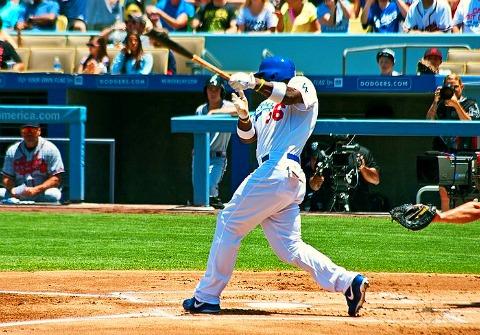
A recent investigative feature on the Los Angeles Dodger’s star player, Yasiel Puig, reveals many of the dramatic—and complicated—facets of the Major League Baseball powerhouse. Puig’s talent is undisputed as an outfielder with famously massive forearms who can exhibit “feats of superhuman strength,” but he is nonetheless a divisive character. Some see him as “a childlike refugee simply trying to adjust to a new world” outside his native Cuba; others as a “cold-blooded, self-involved star with little respect for anything that does not make him shine.”
The baseball connection between the U.S. and Latin populations started in the late 1800s, when Cuban students and sailors in the States introduced the new American game to their countrymen. And despite the onerous number of rules and need for specialized equipment (cough* soccer is objectively better *cough), the past-time spread like wild fire to other Caribbean and Latin countries. But stark racism in American baseball precluded the acceptance of Hispanic players until the end of Jim Crow in the mid 1900s. Animosity was still plentiful toward Hispanics for decades after, however, and only a trickle of players got into Major League Baseball (MLB).
But when profit margins started taking a hit, MLB suddenly got way less xenophobic (funny how that works). American blacks were rapidly disappearing from baseball by the 1990s, turning instead to basketball and football. As MLB lost this critical population of potential players (and fans), the league finally said “Bienvenidos!” to Latin foreigners. Hispanic stars dreaming of fame and fortune in the U.S. began flooding in, and by the early 2000s, Latins constituted a majority of the roster on several major-league teams, and nearly half of all minor-league players.
Puig, who grew up poor in a rural part of Cuba, similarly saw dollar signs in the States, and like other Cuban players before him decided to defect from the island nation. Details of his arrival were previously murky—Puig has refused to speak publicly about his past—but now we have much more of the salacious scoop.
Interviews and court records indicate that after several failed attempts at exiting Cuba (where Puig was paid a whopping $17 per month in the state-run sports program), in 2012 he was successfully transported to Mexico by smugglers beholden to the infamous Los Zetas Mexican drug cartel. But as tends to be the case with murderous Mexican cartel types, things quickly went bad. The smugglers held Puig in a Mexican hotel for more than two weeks in an attempt to extract payment from his benefactor, Raul Pacheco, a supposed Miami air-conditioning repairman. They even threatened to cut off Puig's arm to destroy his ability to play baseball. But Pacheco is a cheapskate, so instead he commissioned another gang to rescue Puig from the hotel (details are hazy, but I bet that was one hell of a scene). They finally delivered him to Los Angeles, and soon after Puig successfully joined the Dodgers with a $42 million contract.
But much is still unclear about the aftermath of this story. It’s common for intermediaries to demand a percentage of smuggled players’ earnings, so is Pacheco collecting on Puig and influencing some of the player’s frustrating antics? Some reports indicate there’s still bad blood between Puig and the stiffed smugglers, including claims they continue to harass Puig for money. So could Puig be connected to the recent execution-style death of one of the criminals? After all, something must be behind the Dodgers’ increase in dugout body guards since Puig’s arrival.
It’s long been established that professional sports have a dark underbelly—from rigging games in the early years of baseball, to a consistent stream of athlete rape allegations, to the apparent epidemic of traumatic brain injury in the NFL. But when you add throngs of foreign athletes to a sport amid a whole slew of legal restrictions on immigration, things get way more intense.
Indeed, while the details of Puig's story sound wild to us, the basic facts are supposedly not uncommon among foreign players in MLB. His story has gotten more press because he’s one of the highest-paid defectors. (Mo’ money mo’ problems.) No other American professional sport has experienced this type of demographic shift in foreign players—which makes Major League Baseball an interesting case study. And while some restrictions on players are starting to change, there’s still a lot of red tape that may continue to foster dangerous scenarios among baseball players for some time to come.
Image: commons.wikimedia.org.






